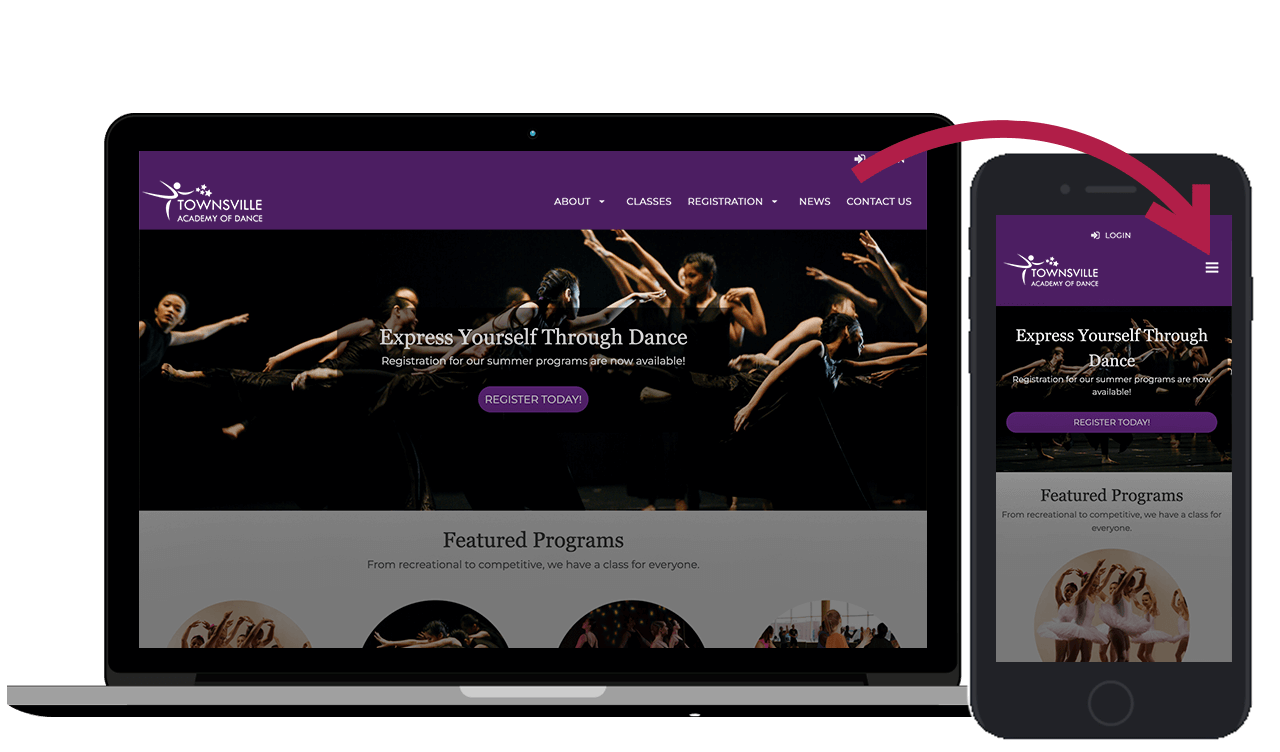Dance studio website design doesn’t have to be complicated. In fact, it’s often best to keep things simple. That doesn’t mean you should create a boring website for your studio, but you do have to be aware of which elements to include, and how to do it.
In this article, we outline 9 dance studio website design tips to help you make a website that visitors can get the most out of.
Let’s jump in!
1) The Most Desired Action for your dance studio website
Your dance studio website needs to have a purpose. In marketing and web design this is often referred to as a call-to-action. But, it’s common for sites to have more than one call-to-action. That’s why you need to prioritize.
For example, let’s say 60% of your visitors want to visit your site to register their child for a dance program, but another 30% may just be seeking out your phone number, and 10% might be looking to try a drop-in class.
You have to appeal to each of these visitor segments, so you need to include three call to actions on your site. But, clearly, one is more important than the others.
In the above case, getting people to register for your programs should be the site’s Most Desired Action. It’s the action that most visitors desire, and most importantly, it’s the action that generates the most revenue for your studio. This means, your entire website should be designed to prioritize this action.
As a result, your design should likely include call-outs to “Register Today” that appear above the fold on your homepage and a “Registration” link in your main navigation (see below).

Note: the term “above the fold” refers to the portion of your website that immediately appears on a visitors screen without needing to scroll. It’s the portion of your site that will get the most eyeballs on it because not everyone will scroll down to see the remainder of your page.
2) Authentic dance studio website images
Having high-quality photos of your studio is easily the second most important element in effective dance studio website design.
Images allow people to quickly understand what your space looks like without having to step foot in your studio.
It’s extremely convenient to scroll through images of your studio, and it’s an important part of evaluating your business. So, when someone visits your dance studio website, just remember they want to see your dance studio. They do not want to see stock images.
The images of your studio need to be clear, and have good lighting. If you’re featuring any action shots of dancers, make sure they’re not blurry. Images that are blurry or have low lighting will reflect negatively on your brand.
If you cannot capture clear, well-lit pictures on your own, it’s a good idea to invest in some professional photos. Ideally, have your photographer arrive before class to get a shot of your empty space and have them stay during class so you can capture all the smiling faces at your studio.

Note: Always be sure your business has obtained the proper permissions to use photos of dancers at your studio. If your business doesn’t already have a media release form, it’s always advised to seek legal counsel when creating one. Once created, these release forms, policies or waivers can be automatically presented and collected as part of your registration (more on that in point 9 below).
3) Create a simple navigation
When someone visits your site, you want them to easily find and complete your most desired action (see point 1). There are two keys to making this happen.
The first key is to prominently display your most desired action with a nice clear call-to-action and clickable link or button that will take them to a page where they can complete that action.
The second key is eliminating everything that is not important to your visitors. Less is more in website design. So, create a clean navigation with a limited number of options that only point to essential pages. For example, you could limit your pages to About, Classes, Registration, News, Contact Us, for example.
If you find that your team wants to add information about an upcoming recital, a bake sale, or a new piece of merchandise, consider creating using a section of your website as a catch-all section. This can be a blog or a news section where all your miscellaneous updates go.
4) Make it mobile friendly
As we’ve written about in our blog about mobile friendly sites, Google now ranks websites on a mobile-first basis. This means Google will first evaluate how your site looks and performs on a mobile device when determining where you show up in search results.
This is crucial to understand. It means your site needs to be designed with mobile top-of-mind.
Your main navigation should collapse into a mobile menu (see below), and all of your content needs to easily shift and resize to display nicely across different mobile devices. (Don’t worry, all dance websites on Uplifter are mobile ready like the one below).

So, if you’re contacting a web designer to create your site, make sure they understand best practice for mobile design!
5) Make your dance studio website load fast
Page speed is an important ranking factor in Google. Basically, the faster your site, the more likely it’ll show higher up in Google search results. Of course, mastering Google search rankings is more complex than that, but having a fast site is vital for good rankings. Furthermore, it’s also an important factor for keeping visitors engaged.
The longer it takes for a page to load, the more likely a visitor will abandon your site. As a result, you need to make your website design choices with page speed in mind.

There are plenty of website designers out there who can make a stunning website with beautiful animations and auto-play video backgrounds. But, just because you can do it, doesn’t mean it’s best for your visitor’s experience or your search rankings!
Whenever possible, opt for design elements that load quickly.
6) Write simple content to help your visitors
Your visitors want your content to be clear and simple. Even if you’ve written a PHD thesis in linguistics and have a masterful grasp on the written word, resist complexity.
The goal of your website is to help visitors complete your most desired action. This goal can’t be completed if they’re struggling to read your content.
Try to write short, simple sentences. Wherever possible, limit your paragraphs to 3 – 4 sentences in length. Although it might seem odd, it’s far easier to read short paragraphs with white space in between them.
7) White space is your friend
This point is closely related to the above paragraph from the ‘Write Simple Content’ section. In short: people’s eyes need white space.
When images and content are too close together it can create a wall of content with no entry point. A wall like this will cause visitors to ignore your content completely. To solve that potential problem, provide ample white space between elements.
Our eyes instinctively seek out openings to start reading or engaging with content.
That’s why newspapers and blogs use a large capital letter to start a news story, or a block quote to highlight an intriguing part of a story.
So, make sure your dance website provides enough space between elements so that visitors can easily engage with content. It’s okay if you have to make a page longer to fit your content in. Longer, more spaced-out content will always be easier for your visitors to consume than content that’s crammed into a small space.
8) Add social proof to encourage registrations
Social proof is a fancy name for customer feedback. It often comes in the form of a review or testimonial. Although it seems simple, social proof is one of the most powerful marketing and sales tactics that there is.
When someone wants to buy a product or service, they’re almost always interested in hearing what other people have to say about it.
In fact, in 2022, TINT found that 75% of consumers are likely to search for reviews and testimonials before completing a purchase. So, give your prospective customers exactly what they want to see!
Consider adding testimonials to your homepage and any page that detail your dance studio’s programs.

Although they are important, these testimonials shouldn’t get in the way of completing your most desired action. Instead, incorporate testimonials and reviews to complement your existing content, whenever applicable.
9) Put your waivers in the right place
Waivers are vital to protecting your business, instructors and dancers. But where is the best place to put them?
There are lots of owners that put their waivers directly on their dance studio website, instructing parents to download waivers, fill them out and bring them to the studio.
This is a tactic that has worked in the past, but there are a lot of unnecessary steps and room for errors. Consider the following:
- Do you make parents signup online, then go and find your waiver on a different site?
- How many parents will have to find a printer to print your waiver so they can sign it and bring it in?
- What if the parent is too busy and delays in getting the waiver handed in?
- How long do you wait until the dancer is removed from your class list and you open that seat to a new dancer?
- Where will you keep all the hard copies of these waivers? And, can you easily retrieve one if you ever need it?
The easier, more reliable way to handle waivers is to leave them off your website all together.
Instead, present waivers in your online registration system.
With Uplifter’s registration system, waivers can be signed with digital signatures during the checkout process. Once completed, waivers are instantly archived with the exact text, signature, and date. Plus, they’re saved directly on the participant’s profile, so you know exactly where to find it, if it’s needed.
If a dancer is completing their own registration, they can also easily and securely email your waiver to their parent or legal guardian to complete. It’s that intuitive.
Simplicity is the key to good dance studio website design
When you consider all nine of these tips together, there is one clear message: simplicity is key. If you run a dance studio with a huge waitlist and have no aspirations to grow your business, some of these tips may not apply. But, for any studio that wants to continue to drive interest and grow their offerings, these tips can provide a powerful catalyst for growth.
Above all else, be clear on your Most Desired Action and ensure your visitors can easily find your site and complete that action.
Have more questions about dance studio website design?
Get in touch with us at info@uplifterinc.com and we’ll be happy to schedule a call to discuss!







